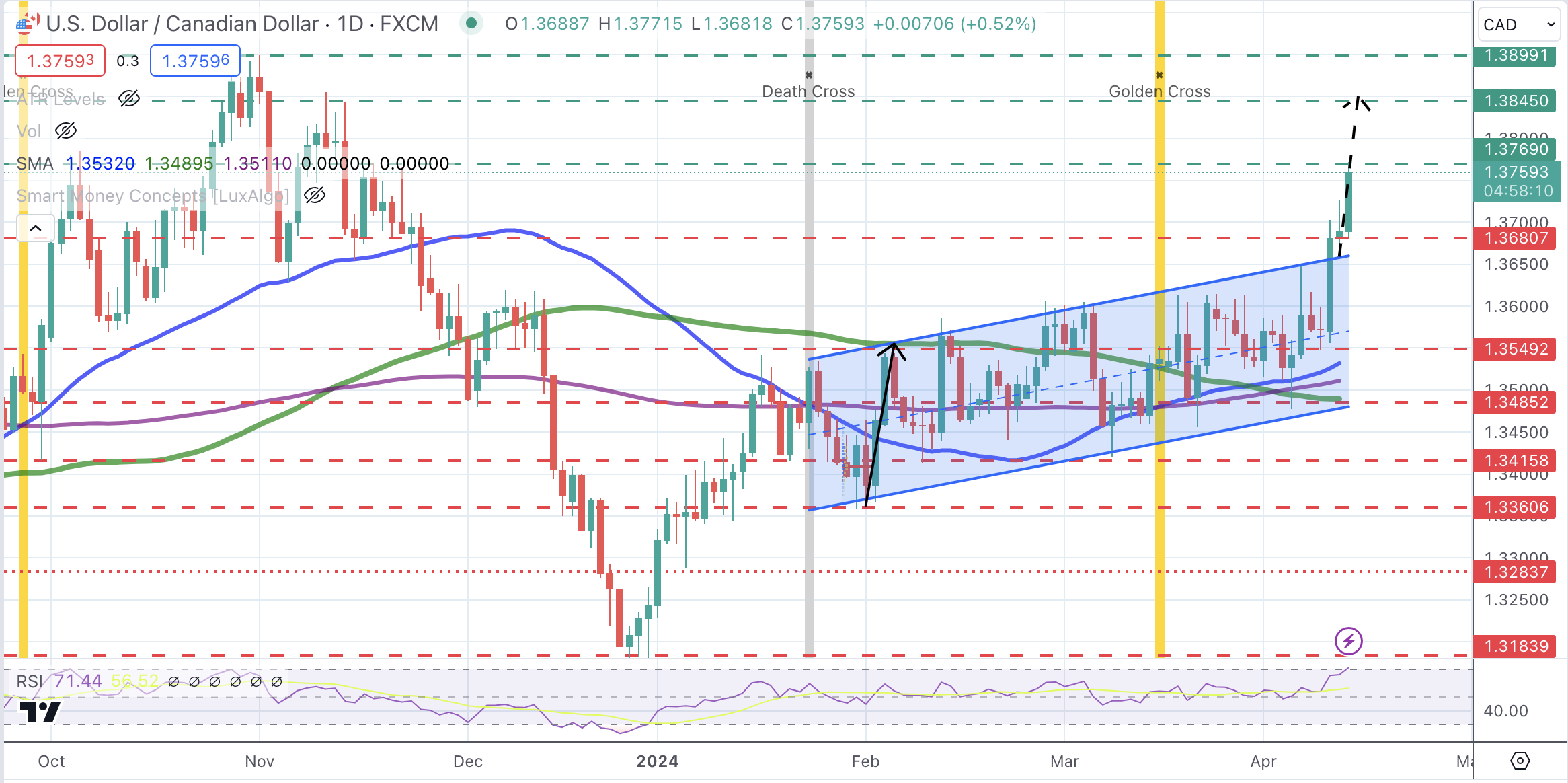- The Canadian dollar continues to fall, while the USD generally rebounds.
- The CAD has depreciated around 1.23% this week, in its worst weekly result in almost a year.
- USD/CAD maintains an uptrend, centered on 1.3770 and 1.3845
The Canadian Dollar (CAD) is losing ground for the third day in a row on Friday, on track to record its worst weekly performance in almost a year. The US dollar advances driven by rising US yields, as the market reassesses the timing and magnitude of the US Federal Reserve (Fed) easing cycle.
The Michigan index of consumer sentiment deteriorated more than expected, although consumers' inflation expectations have picked up. This data has not weighed on the US dollar, which has received additional support from the European Central Bank's (ECB) dovish monetary policy statement.
A little earlier, on Friday, Boston Fed President Susan Collins anticipated a delay in the start of monetary easing, hinting at September, and pointed to just two cuts in 2024.
Daily Market Moves Summary: USD/CAD Steady as Investors Reassess Fed Easing Expectations
- The Canadian dollar continues to decline and is headed for a 1.25% sell-off this week, its worst weekly result since May 2023.
- The Michigan Index of US Consumer Sentiment fell to 77.9 in April from 79.4 in March. The market had anticipated a reading of 79.0.
- University of Michigan consumer 5-year inflation expectations rose to 3% from 2.8% in April.
- US 10-year yields have retreated from highs, although they remain above the key 4.5% level, their highest level since last November.
- Investors have cut their expectations for Fed easing to 60 basis points in 2024, down from 150 basis points forecast in January. The first rate cut is not expected until September. This is acting as a tailwind for the US Dollar.
- Later, Fed members Schmid, Bostic and Daly, all hardliners, will meet with reporters. They may provide more support to the Dollar.
Price of the Canadian Dollar this week
The following table shows the percentage change of the Canadian Dollar (CAD) against the main currencies listed this week. The Canadian dollar was the weakest currency against the US dollar.
| USD | EUR | GBP | CAD | AUD | JPY | NZD | CHF | |
| USD | 1.66% | 1.32% | 1.11% | 1.42% | 0.94% | 0.91% | 0.94% | |
| EUR | -1.69% | -0.34% | -0.58% | -0.23% | -0.74% | -0.76% | -0.73% | |
| GBP | -1.35% | 0.34% | -0.22% | 0.10% | -0.39% | -0.42% | -0.39% | |
| CAD | -1.12% | 0.56% | 0.22% | 0.33% | -0.16% | -0.19% | -0.17% | |
| AUD | -1.43% | 0.26% | -0.09% | -0.32% | -0.48% | -0.50% | -0.49% | |
| JPY | -0.94% | 0.73% | 0.41% | 0.18% | 0.50% | 0.00% | 0.01% | |
| NZD | -0.93% | 0.73% | 0.41% | 0.18% | 0.50% | 0.02% | 0.03% | |
| CHF | -0.96% | 0.71% | 0.37% | 0.16% | 0.49% | -0.01% | -0.04% |
The heat map shows the percentage changes of the major currencies against each other. The base currency is chosen in the left column, while the quote currency is chosen in the top row. For example, if you choose the Euro in the left column and scroll down the horizontal line to the Japanese Yen, the percentage change that appears in the box will represent EUR (base)/JPY (quote).
Technical Analysis: USD/CAD continues to rise, with 1.3770 and 1.3845 in bulls' sights
The US dollar is under strong bullish momentum after confirming itself above the channel ceiling of the last two months, with no change in trend in sight.
The inverse trend line has provided support, triggering another bull run towards the 1.3770 resistance zone, which was tested on Friday. The USD/CAD pair is at overbought levels but not extremes, with the channel's measured target broken at the mid-November high of 1.3845. On the downside, supports are 1.3680-1.3660 and below here at 1.3545.
USD/CAD Daily Chart

Frequently asked questions about central banks
What does a central bank do?
Central banks have a key mandate to ensure price stability in a country or region. Economies constantly face inflation or deflation when the prices of certain goods and services fluctuate. A constant rise in the prices of the same goods means inflation, a constant fall in the prices of the same goods means deflation. It is the central bank's job to keep demand in line by adjusting its interest rate. For the largest central banks, such as the US Federal Reserve (Fed), the European Central Bank (ECB) or the Bank of England (BoE), the mandate is to keep inflation close to 2%.
What does a central bank do when inflation is below or above the expected target?
A central bank has an important tool to raise or lower inflation: modify its reference interest rate. At pre-communicated times, the central bank will issue a statement with its reference interest rate and give additional reasons why it maintains or modifies it (cuts or raises it). Local banks will adjust their savings and loan rates accordingly, which in turn will make it harder or easier for citizens to make a profit on their savings or for companies to borrow and invest in their businesses. When the central bank substantially raises interest rates, we speak of monetary tightening. When you reduce your reference rate, it is called monetary easing.
Who decides monetary policy and interest rates?
A central bank is usually politically independent. Members of the central bank's policy council go through a series of panels and hearings before being appointed to a position on the policy council. Each member of that council usually has a certain conviction about how the central bank should control inflation and the subsequent monetary policy. Members who want a very loose monetary policy, with low rates and cheap loans, to substantially boost the economy, while settling for inflation slightly above 2%, are called “doves.” Members who prefer higher rates to reward savings and want to control inflation at all times are called “hawks” and will not rest until inflation is at 2% or just below.
Is there a president or head of a central bank?
Typically, there is a chairperson who leads each meeting, has to create a consensus among the hawks or doves, and has the final say when votes need to be divided to avoid a 50-50 tie on whether to adjust current policy. The president will give speeches, which can often be followed live, in which he will communicate the current monetary stance and outlook. A central bank will try to push its monetary policy forward without causing wild swings in rates, stocks, or its currency. All central bank members will channel their stance toward markets ahead of a monetary policy meeting. A few days before a monetary policy meeting is held and until the new policy has been communicated, members are prohibited from speaking publicly. This is what is called the silent period.
Source: Fx Street
I am Joshua Winder, a senior-level journalist and editor at World Stock Market. I specialize in covering news related to the stock market and economic trends. With more than 8 years of experience in this field, I have become an expert in financial reporting.







